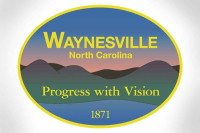Using development to save mountain farms
Not too long ago there occurred an unlikely meeting of the minds. Sylva developer John Beckman and Whittier farmer William Shelton sat down in the back of Sylva’s Spring Street Café with maps and blueprints to talk about the issue of disappearing farmland in the mountains of Western North Carolina.
Beckman began investing in real estate in Jackson County in 1993 and moved here full time in 2000. Prior to that he had been in real estate and historic building preservation in the Triangle area. He’s also a past president of the Carolina Farm Stewardship Association (Mountain Chapter) as well as a member of the Triangle Land Conservancy and the American Farmland Trust. Shelton, on the other hand, was born and raised in Jackson County, went to study agricultural science at the University of Tennessee before returning to his family farm in Whittier, where he has been farming tomatoes, strawberries, lettuce and market vegetables full-time for the past 22 years.
With the kind of explosive economic growth the country has experienced over the last decade and the sky-rocketing rise of real estate development in Western North Carolina, the growing scarcity of family farms and mountain farmland has become a real issue. There is increasing pressure to develop the limited farmland in our region due to its flatland accessibility and site preparation advantages.
Shelton and Beckman have come together to try to find common ground in terms of how their individual professions might benefit one another and to find the basis for some sort of sustainable model for other developers and farmers with respect to balancing land development with environmental protection and farmland preservation.
After discussing parallel issues such as land-use planning, steep slope ordinances and sediment control legislation — which have been the subject of much discussion in recent months throughout the mountain region — the conversation turned to the issue at hand.
Related Items
“I’ve been reading a book titled Collapse,” said Shelton, “which has a chapter about what is going on, now, out in the state of Montana. This is something I know something about, as I’ve been going to Montana to fish, for some time now. The picture that the author paints in this book on the collapse of farmlands and the environment at the hands of industry and housing development is almost an exact mirror of what we are, at present, experiencing here in Western North Carolina.
“Unless we take progressive action, now, in terms of legislation, preservation and education, the full-time residents of Jackson County and its neighboring counties will be looking at a grim picture whereas the future is concerned. Land along this bottom where I farm was selling not long ago for $300 to $500 an acre but is now selling for as much as $100,000 an acre. Flat bottom land is choice real estate here in the mountains, and the prices are only going to rise as out-of-state developers come in here looking for choice sites for their gated communities, retirement and second homes. Why, they’re selling property up in Tuckasegee from helicopters, with buyers not even setting foot on the ground! $300,000 for one-third acre lots.
“With this kind of development, land values are escalating exponentially, and land taxes are becoming so inflated that it’s harder and harder for local people and small family farmers, like myself, to make ends meet. People around here who have farmed for generations are being forced to sell out. This is not only a change in the culture of the community, but a blow to the availability of local food, which affects everyone.”
With the ball now clearly in his court, Beckman was quick to respond.
“I agree that the loss of American farmland to economic pressures and development has reached a precarious point in our history, and that it has become increasingly difficult for the small family farms to remain operationally productive and keep their heads above the rising dangerous waters of American agricultural policies, practices and realities. It seems to me that farmers may need to diversify not only their crops and conventional practices, but the very design and use of their lands if their farms are to remain in their hands as sustainable, productive ground.
“I’d like to suggest, as something of a solution, that it’s time for farmers to get their slice of the development pie and integrate it into their farm plan as a working asset, instead of falling back on the old pattern of a last-ditch sellout to developers. Combining farmlands with development may sound like an oxymoron, but it could prove to be a most useful tool for keeping farm families on the farm.”
Shelton asks Beckman just how this plan would play out and what his formula for implementation would be.
“I’m interested, at this point in my life and as a businessman, to find threatened tracts of farmland and wild acreage and come up with a kind of formula to protect a large portion of them,” said Beckman. “I’m into protecting watersheds as well as bottom farmland. So, first, I need to identify what the key areas or properties are that need to be protected. My ‘plan’ seeks to protect productive farmland by designating specific development areas and a thoughtful list of regulations governing how that development takes place. Emphasis is on minimizing the impacts on the land and water resources and keeping prime farmland in crops, not driveways.”
“Most folks who run Mom-and-Pop businesses here in the mountains where we live have a ‘retirement plot’ set aside to sell and support themselves in old age,” says Shelton. “The farmer, on the other hand, lives in and on his business. So when it comes time to retire, he has to sell the whole farm. Farmers aren’t especially known for investing in retirement options across the period of a lifetime. This being the case, how, then, does your plan benefit the farmers? Could you be more specific about this plan for a progressive development paradigm?”
“I want to put the farmer in the developer’s seat,” Beckman answers. “In other words, the farmer becomes the developer. The design I have in mind and have been promoting is a holistic approach with an emphasis placed on protecting the land and its productive potential. This type of design has been called by others, ‘Conservation-based Community Design.’ This design system takes the best farmlands, saves those, and develops around the farmland on unusable areas and sets the rest of the property in conservation and/or preservation easements.
“Specifically, the development design I have in mind reflects three essential criteria: to provide for long-term protection of the natural beauty, biodiversity, and ecosystems present on the property; to develop sustainable business and agricultural opportunities that support the needs and enjoyment of the residents; and to create a small community atmosphere offering enriching, social, educational, and recreational opportunities for residents and visitors.”
“This all sounds very generous, but what do you, as a developer, have to gain from this scenario?” asks Shelton.
“I have come up with a formula that works for me. Financially, it works out to a near zero-sum gain. I just want to get the bulk of my investment back and to have it available for additional preservation projects. And I’m willing to work on this basis,” says Beckman.
“I’ve just bought 190 acres over on Tilley Creek — the site of the shooting range controversy. I’m planning on selling six lots for homesites, the rest will go into conservation and the bottom will remain in farmland along the creek. If I set the price for the lots slightly above the going price, I should be able to get most of my investment back. Meanwhile, I’ve preserved valuable local farmland and set about 120 acres in conservation.
This, in essence, is my model and my formula. It’s not about huge profits, it’s about recouping your investment and saving large tracts of tillable bottomland, as well as a large percentage of the watershed, and then moving on to the next piece of land that is crying out for preservation. ”
“I see what you’re getting at, here,” says Shelton. “But local people won’t be able to afford to buy land at these kinds of prices. How does this help local people and their need for affordable, even low-income housing?”
Beckman: “Yes, the pitfall of my projected program is that it’s going to cost a quarter million dollars for a house-site — which often means bringing in wealthy people from the outside. This scenario has, up until now, been part of the problem. So, admittedly, my scenario doesn’t account for these particular community needs you‘re speaking about. Where we succeed in preserving valuable land, we fail to provide low-cost homesites. Additional programs need to be developed that specifically address this issue.”
Shelton: “We’re in a race against time. It looks to me like there needs to be some kind of county involvement, then, if this farmland preservation plan of yours is going to work. We’re going to need several ‘tools’ — accessible and yet comprehensive tools when looking at the overall picture. What I see is some kind of partnership between the county, land trusts, real estate investors and private individuals and groups working together with the betterment of the county in mind.”
Beckman: “Yes, you’re right. We’ll need to create public/private partnerships as working models. As farmer-developers we’ll have to work with land trusts and county governments for this scenario to succeed.”
Shelton: “This is a very unselfish design concept. You’re a developer. Developers are known for their profit incentives. What’s given you the incentive to come up with this preservation concept and to actually put it into practice here in Jackson County?”
Beckman: “I’ve been working on farms since I was 4 years old. It started with my grandfather teaching me how to plant peas. More recently I’ve been growing truck gardens and selling produce to local families, farmers markets and local businesses. I’ve become attached to my new geographical home in Jackson County and my adopted community, and want to see it survive this latest historical assault on it’s integrity.
“In terms of incentives, if not me, then who will be willing to be an advocate for farmland preservation? These big out-of-state developers aren’t going to step up, and farmers have rarely been able to satisfactorily organize to protect themselves.
“I see America making huge mistakes in terms of farmland policy. And I think that we, here in the mountains, need more local food sources. Keeping local farms intact promotes food security, reduces transportation costs and fuel consumption, preserves rural landscapes and encourages good environmental stewardship”
Shelton: “My best guess is that we’re going to need local food in the future. With no farmland or farmers left, who’s going to provide local foods? In terms of the kind of partnerships we’ve been talking about, I can envision local farmers working with the county in terms of supplying produce to school food programs, Meals on Wheels, and other county-supported food services. Better quality food for less money, which is a win for the local farmer and a win for all these services and their recipients.”
Beckman: “In this country at the moment, it all comes down to the bottom line. In a capitalistic society, money is king. The challenge is how to inject values into the system. Cash is like fish. You gotta keep it moving or it goes bad. My feeling is, why not use it in a positive and progressive way? By having a farm at the center of a development, residents and visitors can’t help but become connected with the importance of food and fiber production at the local level. My hope is that the current interest regarding organic foods could carry over into the farmland real estate market and into the consciousness of potentially enlightened developers and buyers — creating a fad or trend for future farmland preservation.
“There’s a lot of good information available about sustainable farming practices and improving soil health, but this concept of ‘farm-development planning’ seems to have been overlooked. I’m hoping that our efforts here, today, will be a beginning that will encourage other farmers to diversify their farm plans with strategies that succeed in keeping their farms in sustainable production.”
Shelton: “Yes, and it would be great to see a marriage between local markets and producers. This would take a lot of stress out of the marketing side of my business and be, ultimately, more rewarding. And then I could lease my farm to new, young farmers when I’m ready to retire.”
(John Beckman can be reached at Blue Ridge Watershed Stewards LLC at This email address is being protected from spambots. You need JavaScript enabled to view it.. William Shelton can be reached at Shelton Farms at This email address is being protected from spambots. You need JavaScript enabled to view it. )
Thomas Crowe is a contributing writer to The Smoky Mountain News and author of the award-winning nature memoir Zoro’s Field: My Life in the Appalachian Woods, which was serialized in The Smoky Mountain News and has just been released in paperback from the University of Georgia Press.









